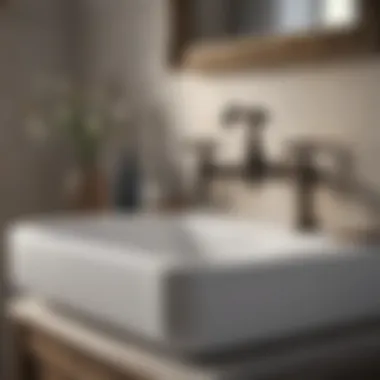Stylish Small Farmhouse Bathroom Sink Ideas


Intro
Designing a small farmhouse bathroom sink is not just about picking a fixture; it’s a journey into creating a space that balances charm with utility. Homeowners increasingly seek to blend aesthetic appeal with practicality, particularly in smaller bathrooms where every inch matters. This guide aims to navigate the complexities involved in selecting, arranging, and styling a sink that resonates with farmhouse ideals while also serving modern needs.
In the hustle and bustle of daily life, a bathroom often becomes a retreat, a place to unwind and refresh. As such, the sink takes center stage in functionality and design. This article will explore trending styles that highlight both contemporary and rustic influences, delve into suitable materials that withstand daily use while looking good, and offer insights on how to place your sink for optimal space use.
Let’s dive into the styles to see what resonates with your vision of a cozy yet functional bathroom.
Understanding the Small Farmhouse Bathroom Aesthetic
The aesthetic of a small farmhouse bathroom goes beyond mere decoration; it embodies a way of life that seeks to balance practicality with comfort. By understanding this aesthetic, one can create a bathroom space that resonates with warmth, charm, and a sense of nostalgia. The appeal of farmhouse design lies in its simplicity, yet it offers immense scope for personalization, ensuring every homeowner can carve out their own sanctuary.
Historical Context of Farmhouse Design
The farmhouse style has deep roots in history, predominantly arising from rural America in the 19th century. The design evolved out of necessity, with builders often utilizing locally sourced materials. This approach resulted in homes that were functional yet full of character. Each design element usually told a story, from the original wood beams to handmade fixtures.
Today, the revival of interest in this aesthetic reflects a yearning for connection with the past. Homeowners are increasingly drawn to the rustic charm, where imperfections become part of the appeal. Tattered wood, vintage décor, and repurposed items speak volumes about heritage and authenticity—not to mention that history has a way of adding soul to any space. This context is crucial when considering the design for a small farmhouse bathroom. It guides decisions on materials, finishes, and the ever-important sink selection, all while crafting a narrative that pays tribute to bygone eras.
Core Elements of Farmhouse Style
Core elements of farmhouse style include both aesthetic decisions and functional aspects. Below are some defining features:
- Natural Materials: Wood, stone, and metals are prominent in a farmhouse bathroom. They not only add a rustic touch but also ensure durability.
- Neutral Palette: Light, earthy tones help create a serene setting. The focus here is on creating an open, airy feel that echoes the simplicity of farmhouse living.
- Functional Spaces: Farmhouse design prioritizes functionality. Every item, especially in small spaces, must serve a purpose—be it a wooden cabinet or a spacious sink.
- Vintage Accents: Incorporating vintage light fixtures or reclaimed mirrors can enhance authenticity. Often, these items become conversation starters.
- Cozy Textiles: Soft towels, woven baskets, and natural fiber rugs contribute to warmth and comfort, crucial for enhancing the overall ambiance.
Understanding these elements allows homeowners to thoughtfully select elements for their bathrooms, creating a unified look that embodies the welcoming spirit of farmhouse design. Every decision should reflect both style and a sense of home, making the space a truly personal retreat.
Essential Considerations When Choosing a Sink
When selecting a sink for a small farmhouse bathroom, one cannot overlook the critical aspects that influence not only the functionality but also the visual appeal of the space. The sink is, in many ways, the centerpiece of the bathroom; its design and location can significantly impact both aesthetics and utility. Understanding these considerations ensures that the sink harmonizes with the overall decor while meeting practical needs.
Space Constraints and Measurements
Navigating the tricky terrain of space constraints in small bathrooms is not for the faint of heart. Each inch counts, and before any design choices are made, a thorough measurement of the available space is essential. Here are some practical steps to keep in mind:
- Measure Twice, Buy Once: Use a tape measure to get the exact dimensions of the area allocated for the sink. Consider height, width, and depth. Misjudging these measurements can lead to ill-fitting choices.
- Consider Layout: Is the sink positioned against a wall, or is there room for a cabinet setup? Wall-mounted sinks tend to offer a sleek, modern look and free up precious floor space, while freestanding options may provide more style but can make the area feel cramped if not chosen wisely.
- Think about Traffic Flow: Allowing space for movement is key. Consider how many individuals will be using the bathroom—if it's a busy household, ensure there’s enough space for people to navigate without bumping into one another.
"Good design is about making sure all parts work together. In a small space, this means every detail must be worthy of its place."
Functionality vs. Aesthetic Appeal
Choosing between functionality and aesthetic appeal can feel like being caught between a rock and a hard place. However, the ideal sink should gracefully blend both aspects, ensuring it is as practical as it is beautiful. Here are some nuances to think about:
- Daily Use: Consider how the sink will be utilized on a daily basis. If it will see heavy usage, opting for a durable material like cast iron may be prudent. Alternatively, a delicate porcelain sink could serve as a visual delight but may not withstand the rigors of heavy everyday use.
- Design Choices: A farmhouse aesthetic often leans toward rustic charm. A vintage sink or one with an old-world finish can transport one’s imagination back to simpler times, while a sleek, modern option may clash with traditional elements. It’s about finding that sweet spot that respects the overarching theme of your farmhouse.
- Accessories and Style: Don't forget about how sinks interact with accessories—think faucets, cabinetry, and lighting. A well-chosen faucet that matches or complements the sink can elevate the entire setup, making it functional and pleasing to the eye.
Balancing these two factors isn't necessarily easy, but by carefully assessing both functionality and aesthetics, homeowners can achieve a harmonious bathroom setup that captures the essence of farmhouse style without sacrificing practicality.
As you ponder over these essential considerations, remember that thoughtful choices today will lay the foundation for a bathroom that’s not only a feast for the eyes but also a functional haven.
Exploring Sink Styles That Complement a Farmhouse Theme
When considering the design of a small farmhouse bathroom, the sink style becomes a focal point around which the rest of the space can harmoniously revolve. The particular choice of sink can greatly influence the overall feel of the bathroom, marrying functionality with the rustic charm that defines farmhouse aesthetics. The right sink not only serves its purpose but can also accentuate the warmth and simplicity that are hallmarks of this design philosophy.
Embracing various sink styles allows homeowners to explore their own tastes while ensuring that the bathroom interior feels cohesive. With the appropriate styling, one can navigate practical needs while still creating an inviting atmosphere. It sets the stage for everything from the materials used to the accessories chosen, making it a critical decision in the overall bathroom design process.
Vintage and Antique-Inspired Sinks
Vintage and antique-inspired sinks often capture a sense of nostalgia that is appealing to many. Think of sinks made from enamel or porcelain, which reflect a bygone era, or those uniquely crafted designs that stand as statements in their own right. These sinks typically feature ornate details, like decorative faucets or intricate tiling, blending history with charm.
"Choosing a vintage sink is like adopting a piece of history into your home. Each scratch tells a story, adding character to your space."
While these sinks can bring an evocative presence, they also raise considerations regarding maintenance and repair. Finding original parts can sometimes be a challenge, a crucial point for anyone considering making this choice. That said, well-maintained vintage sinks can elevate the functionality and style of a small bathroom, adding layers of depth and interest that resonate with farmhouse values.
Modern Interpretations of Farmhouse Sinks
Modern interpretations of farmhouse sinks take traditional concepts and give them a fresh spin. These are often sleek and minimalist, featuring cleaner lines but still evoking the farmhouse style through their larger-than-life presence. Undermount or apron-front sinks made from stainless steel or composite materials can serve practical purposes while embodying contemporary survival of the farmhouse ethos.
The benefit here lies in blending functionality with aesthetics. Modern sinks can deliver a high level of durability and easy maintenance, offering peace of mind in households with active lifestyles. Moreover, these designs often come in a variety of colors, allowing homeowners to coordinate their sink choice seamlessly with the rest of the bathroom decor, finally bridging old and new without missing a beat.
Wall-Mounted vs. Freestanding Options
Choosing between wall-mounted and freestanding sinks can significantly affect the spatial dynamics in a small farmhouse bathroom. Wall-mounted sinks can make the space feel larger by creating visual lightness, coupled with easy cleaning beneath them. This is particularly important in smaller bathrooms where every inch counts, allowing for an uncluttered, streamlined aesthetic.
Conversely, freestanding sinks offer a more robust presence and can become the centerpiece of a bathroom design. With classic pedestal sinks or chic console styles, these models project an aura of timelessness and can often provide extra storage or surface area. They can help to anchor other design elements like cabinetry or fittings, providing a balance between openness and structure.


Ultimately, the choice between wall-mounted and freestanding sinks lies in the individual needs of the space and the personal preferences of the homeowner. Each has its unique appeal, and selecting the right one can complement the farmhouse theme beautifully while ensuring that the bathroom remains functional and aesthetically pleasing.
Material Choices for Farmhouse Bathroom Sinks
Choosing the right material for a farmhouse bathroom sink plays a significant role not just in terms of functionality but also in the overall design and aesthetic appeal. It's more than just selecting a basin; materials not only offer practical benefits but resonate with the visual language of a farmhouse-style bathroom. The perfect balance between durability, upkeep, and style can transform a space from mundane to inviting.
In selecting materials, homeowners must consider how these choices enhance the ambiance. Sinks can set the tone, essentially forming a centerpiece around which the rest of the bathroom gathers. Plus, with many practical elements at play, it's essential to keep in mind how certain materials fare against daily use and wear.
Ceramic Sinks: Timeless and Durable
Ceramic sinks are an enduring classic that fits neatly within the farmhouse aesthetic. They have a smooth surface, allowing for easy cleaning and a shiny, inviting appearance. Their resistance to staining makes them particularly well-suited for a bathroom, where splashes and soaps might leave their mark. Also, ceramic offers immense versatility in terms of style - be it a vintage white porcelain sink, or one in more dramatic hues like deep blue or black.
A few points to remember when selecting a ceramic sink:
- Durability: These sinks can withstand daily wear and tear, with proper care they can last a lifetime.
- Style Adaptability: Easily integrates into various themes, from rustic chic to more modern interpretations.
- Cost-Effectiveness: While they may have a higher upfront cost compared to plastic, their longevity often justifies the price.
"Ceramic sinks bring a warmth and elegance, capturing that classic farmhouse charm that many homeowners desire."
Cast Iron and Composite Materials
Cast iron sinks are known for their robust construction and classic appeal. Typically coated with enamel, they provide an enduring surface that's resistant to scratches and chips. The cast iron surface offers exceptional heat retention, making it beneficial in colder climates. Although heavier compared to other materials, the weight adds a sense of permanence to the bathroom space.
On the other hand, composite sinks have gained traction for their contemporary twist on farmhouse aesthetics. Made by blending acrylic or resin with natural stone particles, they’re designed to mimic the look of natural materials while being incredibly lightweight. Advantages include:
- Wide Range of Colors and Styles: Perfect for homeowners wanting to match specific color palettes.
- Less Prone to Damage: These materials tend to resist scratches and stains effectively.
- Affordable: Often more budget-friendly than solid stone options while still offering style and functionality.
The Role of Stone and Concrete in Design
Integrating stone or concrete into bathroom designs can add an element of raw beauty. Natural stone sinks, be it granite or marble, possess unique patterns that ensure each piece is one-of-a-kind. They bring a touch of luxury, complementing the rustic elements often found in farmhouse style.
Concrete sinks have emerged as a trendy choice among those desiring a more industrial feel. The ability to mold concrete means various shapes can be crafted and can easily combine functionality with artistic elements. Key attributes include:
- Robustness: Both stone and concrete are durable, standing strong against the wear typical in bathrooms.
- Customizability: Sizes, shapes, and finishes can be adjusted to fit the homeowner's unique style.
- Eclectic Appeal: Stone blends beautifully with wood, metal, and other elements, allowing for a more integrated look that supports the farmhouse ethos.
When considering materials for your farmhouse bathroom sink, reflect on how they serve both practicality and aesthetic synergy within the space. A thoughtful choice can both elevate functional design and create a cozy, welcoming atmosphere.
Placement and Integration of the Sink
When it comes to designing a small farmhouse bathroom, the location and integration of your sink can make or break the space. The sink is not just a functional element; it's often the focal point, enticing your visitors to stop and appreciate its beauty. Carefully considering the placement ensures not only convenience but also enhances the overall aesthetic appeal of the room.
Optimal Sink Heights for Comfort
While the charm of a farmhouse sink cannot be overstated, getting the height just right is essential for comfort and usability. Generally, standard bathroom sink heights hover around 30 to 36 inches. However, what feels comfortable can vary significantly depending on your personal height. For example, taller individuals might find it more comfortable to have a sink height closer to 36 inches, enabling them to wash up without straining their backs.
Writing down the heights you and your family use frequently can help you visualize the best height option. In the end, it’s all about creating that cozy, inviting vibe while avoiding any back pain from awkward angles!
A sink at the wrong height can turn a serene bath into a chore. Knowing your family’s heights can guide a wise choice!
Proximal Elements: Cabinets, Mirrors, and Fixtures
Integrating the sink seamlessly with other elements is crucial in small spaces. Think about the relationship between the sink and adjacent cabinets, mirrors, and fixtures. Closely placed cabinetry can offer the convenience of storing toiletries while keeping everything looking tidy. Consider using reclaimed wood for those cabinets to ensure harmony with the farmhouse aesthetic.
Mirrors play a dual role; they add style while visually expanding the space. Placing a well-chosen mirror above the sink can create the illusion of a larger area. Vintage mirrors with ornate frames often do wonders in enhancing the rustic feel.
Fixtures are also critical here. Opting for a brushed nickel or oil-rubbed bronze finish can blend beautifully with your chosen sink style, reinforcing the overall look while making a statement at the same time. Each piece you choose should resonate with the farmhouse theme yet cater to modern functionality -- a balancing act worth doing wisely!
Maximizing Counter Space and Storage
In a small bathroom, every inch counts. Your sink should allow you to maximize counter space while also providing storage options without compromising on style. Open shelving below the sink can make it easier to grab items while keeping them in view. You might want to install a small cabinet or a stylish wicker basket underneath to stow away less decorative items.
Moreover, consider wall-mounted sinks when space is extremely limited. These sinks free up floor space, making the room feel larger while providing options for small items on nearby shelves. Accessories like small potted plants can be added in line with the farmhouse theme.
It’s also helpful to think about how these elements will integrate. They should be functional and aesthetically pleasing, contributing to a cohesive design that feels both inviting and practical. The little details will surely enhance the experience, turning mere functionality into something that resonates.
Having a thoughtful approach to the placement and integration of your farmhouse sink will not only enhance the beauty of your small bathroom but also provide the comfort and convenience that every homeowner seeks.
Enhancing the Bathroom Atmosphere with Accessories
Creating a small farmhouse bathroom isn't just about selecting the right sink; it’s about establishing an entire ambiance that flows seamlessly with your taste and functionality. Accessories play an essential role in amplifying the character of this intimate space. They can be the cherry on top, providing that final touch which transforms a simple bathroom into a stylish haven.
By thoughtfully choosing accessories, one can balance practicality with an inviting atmosphere. This section will delve into three crucial areas: faucets, natural elements, and textiles. Each of these will function not only to elevate design but to enhance user experience within the small confines of your bathroom.
Selecting Faucets that Harmonize with Sink Design


The faucet serves as the focal point above the sink, making its design a key player in the overall aesthetic. A well-chosen faucet can complement the sink while reinforcing the rustic farmhouse style. Here are some factors to consider:
- Style Consistency: Choose faucets that resonate with the design of your sink; for instance, a vintage-style sink pairs beautifully with a polished brass faucet that mimics the charm of bygone eras.
- Functionality: Think about the kind of use the faucet will see. If your household has little ones, a pull-down spout can be quite handy, while a single-handle faucet may simplify operations in a tight space.
- Finish: The finish can profoundly affect the room's vibe. Think about matte black or brushed nickel for a modern twist, or go for a tarnished bronze to evoke old-world charm.
"A faucet is like an artist's brush; it can paint the whole picture of your bathroom's ambiance."
Incorporating Natural Elements
In a farmhouse-styled bathroom, the goal often lies in creating a genuine connection with nature. Natural elements not only add to aesthetics but can also enhance well-being by bringing in a slice of the outside world. Consider these incorporation ideas:
- Plants: Small potted plants or hanging herbs can infuse a splash of green and purify the air. Plants like pothos or ferns are low-maintenance and fit perfectly in small spaces.
- Wood Accents: Wooden shelving or a rustic stool can serve as both storage and decoration. The texture of wood introduces warmth, making the space feel cozy and inviting.
- Stone or Pebbles: Using small stones or pebbles in decorative containers adds an earthy charm. This is a simple and affordable way to bring texture and color into your bathroom.
Choosing Towels and Textiles for Cohesion
Textiles, often overlooked, are a means of tying the room together. The right towels and other fabric elements can foster a cohesive look while catering to the practical needs of daily life. Here’s how to select textiles:
- Color Palette: Choose textiles that harmonize with your bathroom's color scheme. Soft whites or earthy tones can enhance the farmhouse look and keep the atmosphere light.
- Textures: Layer different textures—think linen for towels, a woven basket for storage, or a cotton bath mat—each brings dimensionality to your space.
- Functionality and Comfort: Consider the function of each textile. Are the towels plush enough for comfort? Is the shower curtain water-resistant yet aesthetically pleasing?
Maintenance and Care for Small Farmhouse Sinks
Maintaining a small farmhouse sink goes beyond keeping it clean; it ensures its longevity and keeps your bathroom looking its best. Your sink is often the focal point of the bathroom, and like any well-loved piece, it deserves a bit of attention. Good maintenance can prevent minor issues from turning into bigger headaches while keeping the charm and functionality intact. Here, we explore essential maintenance routines, preventive measures, and long-term care tailored to various materials a farmhouse sink may be made of.
Daily and Weekly Cleaning Routines
Maintaining a clean sink requires a consistent routine. Ideally, after each use, quickly rinse the sink and wipe away any lingering soap residue or water spots. For a deeper clean, adopt the following practices:
- Daily Wipe Down: Use a soft sponge or cloth with warm water and a mild detergent to clean the sink every day. Avoid abrasive materials that could scratch the surface.
- Weekly Scrubbing: Set a specific day each week to give your sink a thorough cleaning. This might include using a non-abrasive cleaner designed for the material of your sink, ensuring you read labels carefully. For ceramic sinks, for instance, a mixture of baking soda and water can work wonders.
- Monthly Buffing: Once a month, consider using a specialized polish to enhance the shine and protect the surface. This is particularly relevant for metal sinks, which can tarnish over time if not cared for properly.
Preventive Measures Against Damage
> Prevention is better than cure; this holds particularly true for farmhouse sinks, as small nicks and scratches can lead to bigger issues down the road.
Taking precautionary steps can effectively shield the sink from wear and tear:
- Avoid Hot Items: Never place hot pans or utensils directly into the sink, especially when it's made from materials like enamel or plastic. Instead, keep a trivet handy for hot items.
- Use a Sink Mat: For extra protection, consider placing a sink mat or grid at the bottom of the sink. This helps reduce the risk of scratches and allows the sink to drain effectively without debris clogging up.
- Regular Inspections: Every so often, check for cracks, chips, or signs of mold. Catching these issues early often makes repair or replacement far less daunting.
Long-term Care for Different Materials
Different materials require tailored approaches to care. Here’s a quick guide to keeping your farmhouse sink in tip-top shape based on what it’s made of:
- Ceramic: This material is known for its durability but can chip. Regular polishing can maintain its luster. Harsh chemicals should be avoided as they might dull the finish.
- Cast Iron: Treat it kindly; food acids can cause damage and rust. After cleaning, dry the sink thoroughly to avoid moisture sitting on the surface.
- Composite: Easy to maintain, yet it can become dull. A gentle cleanser followed by occasional waxing can enhance the finish. Avoid extreme heat and harsh chemicals.
- Stone and Concrete: These are beautiful but porous. Regular sealing is crucial to prevent staining. Clean with a pH-neutral cleaner to maintain the surface integrity.
Implementing a well-rounded maintenance plan will keep your small farmhouse sink singing through the seasons. With routine cleaning, attention to detail in handling, and understanding the specific care needs of your sink’s material, it can remain a centerpiece of your bathroom for years to come.
Trends in Small Bathroom Design
The realm of small bathroom design sees continuous evolution, reflecting both changing lifestyles and shifting values among homeowners. This article delves deep into current trends that are pivotal when considering a small farmhouse bathroom sink. Adapting to these trends not only enhances the aesthetic appeal but also prioritizes comfort and utility, which is vital in smaller spaces. Homes, often seen as sanctuaries, should blend functionality and style seamlessly. Keeping an eye on the latest trends can mean the difference between a cramped space and a cozy retreat.
Sustainability and Eco-Friendly Choices
In recent years, there has been a significant push towards sustainability in design. Homeowners increasingly prefer eco-friendly materials and fixtures. Choosing a small bathroom sink that minimizes water usage is a step towards creating a more environmentally friendly home.
- Water-Saving Fixtures: Look for faucets and showerheads that boast low-flow technology. They reduce water consumption without sacrificing performance, allowing you to maintain a functional space while being kind to nature.
- Sustainable Materials: Sinks made from reclaimed materials, bamboo, or recycled glass not only serve a practical purpose but also make a significant environmental statement. These necessitate less energy to produce than traditional counterparts and bring a unique character to your farmhouse design.
- Biodegradable Cleaning Products: When maintaining your sink and bathroom, opt for cleaning supplies that break down naturally in the environment. Strong chemicals can affect the water system, making this choice essential for eco-conscious homeowners.
By embracing these choices, a small bathroom can embody the principles of sustainability while still being a durable and stylish area in the home.
Integrating Technology for Modern Bathrooms
The intersection of technology and design opens new avenues for optimizing small spaces. This trend emphasizes the integration of smart solutions that not only enhance convenience but also bolster the space's efficiency. For homeowners looking to modernize their farmhouse bathroom, technology can play a significant role.
- Smart Faucets: These faucets allow for touchless operation, which is not only convenient but also promotes hygiene. They can regulate water flow according to your needs, making them both practical and efficient for smaller bathrooms.
- Innovative Lighting Solutions: Utilization of LED technology, smart bulbs, and dimmers can adapt to various tasks, whether it’s during a relaxing bath or a quick morning routine. Ambient lighting can visually enlarge a space, creating an illusion of greater depth and breadth.
- Mirror Technology: Mirrors that include features like defogging or integrated lighting can greatly enhance the functionality of a small sink area. Such mirrors assist in maximizing the light in a confined space and improve the experience of getting ready each day.
By taking advantage of modern technology, homeowners can transform their small farmhouse bathrooms into efficient, user-friendly sanctuaries that reflect both modern aesthetics and practical needs.
Important Note: The true beauty of designing a small farmhouse bathroom lies in harmonizing these trends to suit individual preferences while maintaining a cohesive look that celebrates simplicity and comfort.
Budgeting for a Small Bathroom Renovation
Budgeting is often the heart of successfully renovating a small farmhouse bathroom sink. Not only does it dictate what types of materials and fixtures you can afford, but it also influences the overall design and functionality of the space. A well-thought-out budget allows homeowners to prioritize key elements that truly make a difference in both aesthetic and practical terms.
It’s crucial to account for every detail, from the cost of the sink itself to the accompanying fixtures, cabinetry, and any potential plumbing updates that might be needed. This attention to detail can save money in the long run by avoiding costly surprises down the line.
Moreover, understanding how to allocate funds can help homeowners make informed decisions about where to splurge and where to save, ultimately leading to a more cohesive look in their bathroom design. By detailing both the expected costs and strategies for optimizing their budget, this section aims to equip readers with the knowledge they need to navigate the financial aspects of their bathroom renovation with confidence.


Estimating Costs: What to Expect
When diving into the numbers, it’s good to have a clear picture of what you’re getting into. A small bathroom renovation might typically range anywhere from a few thousand to upwards of fifteen thousand dollars. Factors that drive costs include the quality of materials, the complexity of installation, and whether you opt for professional help or go the DIY route.
Here’s a rough breakdown of what costs might include:
- Sink and Faucet: Expect to pay between $200 - $1,500, depending on the brand and features.
- Cabinetry: Custom cabinets can vary from $300 to $3,000, while ready-made options might be cheaper.
- Countertops: Materials like granite or quartz will cost more; think anywhere from $500 to $2,000.
- Plumbing: If alterations are necessary, costs can quickly rise, with labor fees added.
- Tiles and Flooring: These can range from $1 to $20 per square foot.
Homeowners should also factor in a buffer—typically around 10-15% of the total costs—for any unexpected expenses.
Where to Save and Where to Invest
When it comes to balancing your budget, knowing where to cut corners can be incredibly strategic.
- Save on:
- Invest in:
- Fixtures: Opting for more budget-friendly faucets and accessories can free up funds for essential elements.
- DIY Projects: If you're handy and willing to learn, this can significantly reduce labor costs.
- Cabinetry: Considering pre-fabricated cabinets rather than custom can lead to substantial savings without sacrificing style.
- Sink: A quality sink is the centerpiece of the bathroom and is worth investing in for both longevity and appeal.
- Countertops: High-quality materials not only elevate the visual impact but also withstand daily usage better.
- Plumbing Work: Doubling down on a professional plumber can save you headaches and additional costs from future mishaps.
"A budget isn't just a set of numbers; it's a reflection of your priorities."
In the end, being smart with your budget can ensure that your small farmhouse bathroom sink renovation achieves both beauty and functionality while aligning with your financial reality. Prioritizing essential elements can lead to a space that feels both personalized and practical.
Real-Life Examples of Small Farmhouse Sink Installations
Delving into real-life examples of small farmhouse sink installations opens a window into the practical magic of design applied in everyday settings. It’s not just about the imagined ideals of what a farmhouse sink could be, but rather how these designs meld seamlessly into homes, enriching the lived experience. This section serves as a treasure trove of inspiration for homeowners who want to marry aesthetics with functionality in their own spaces. The utility of these examples lies not only in their visual appeal but also in the lessons they impart about space management, material choice, and ambiance creation.
Case Studies of Successful Designs
A thorough examination of real installations yields a wealth of insights. Take, for instance, a small farmhouse from the rolling hills of Oregon. The homeowner opted for a Fireclay sink, characterized by its deep basin and glossy finish. The decision hinged on its durability and ease of cleaning, ensuring that practicality didn't take a back seat to style. Complemented by reclaimed wood cabinetry, this sink ties the entire room together, presenting a cohesive look that feels both fresh and rustic.
- Key Element: The juxtaposition of modern functionality with vintage aesthetics.
- Benefit: Maintains a timeless feel while providing efficient use.
- Consideration: The choice of materials should be resilient to the humid bathroom environment.
Another notable example is a farmhouse bathroom in a renovated cottage in Vermont. Here, the owner chose a cast iron sink with a classic apron front. The gloss of the sink plays beautifully against the backdrop of exposed brick walls, highlighting the charm of imperfection that defines farmhouse decor.
- Key Element: Use of contrasting textures enhances depth.
- Benefit: Creates a striking focal point while embracing rustic heritage.
- Consideration: Weight and support must be factored in when installing heavier sinks.
By analyzing such case studies, readers can gather a vivid image of how thoughtful design translates into real-life spaces, providing inspiration for their own projects.
User Testimonials and Insights
Real feedback from owners who have navigated the small farmhouse sink journey offers invaluable insights. For example, one homeowner from West Virginia expressed how their vintage farmhouse sink transformed their bathroom.
"It was love at first sight with the sink. After all the searching, finally finding the right one felt like gold at the end of a rainbow. Now, it’s not just a utility; it feels like a piece of art in my home!"
This sentiment underscores a vital aspect of design: the emotional connection to elements that might seem purely functional at first glance. Homeowners share how their choices affect not only aesthetics but the overall atmosphere of the space.
Another user, a busy mom from North Carolina, remarked:
"The deep basin means less splashing around. I can fit a lot more in there when washing up—it's a lifesaver! The look just adds that cozy charm we adore."
These testimonials reflect a theme that resonates deeply with many homeowners: the balance of beauty and practicality. The insights gathered from actual users serve to underscore the importance of selecting a sink that resonates with daily practices, without compromising on the farmhouse charm.
In closing, these real-world examples and user testimonials demonstrate that designing a small farmhouse bathroom sink is a nuanced endeavor. It is about crafting a space where functionality and aesthetic desires converge harmoniously, leading to a serene yet stylish retreat.
Final Reflections on Small Farmhouse Bathroom Sinks
Designing a small farmhouse bathroom sink transcends the mere act of selecting a fixture; it becomes an intimate dance between style, functionality, and personal expression. As we've journeyed through the various aspects of this subject, it's clear that each choice made in this space has lasting implications. Whether you’re a seasoned decorator or a homeowner taking your first plunge into renovation, understanding the significance of thoughtful design cannot be overstated. The sink often serves as the focal point of the bathroom, influencing not only the visual appeal but also the overall experience of the space.
The Lasting Impact of Thoughtful Design
The role of a thoughtfully designed bathroom sink goes beyond aesthetics. It enhances the functionality of the space while simultaneously reflecting the homeowner's taste. A well-chosen sink can unify design elements, guiding the eye and creating a sense of balance and harmony. For example, a vintage porcelain sink can blend beautifully with rustic wooden cabinets, instilling a sense of nostalgia and warmth.
Additionally, ergonomic considerations—such as height and basin size—must blend with design ideals. Choose high-quality materials that add durability while offering unique textures. Each detail, from the faucet design to the sink's surface finish, can serve practical purposes as well as enrich the ambiance.
"Design is not just what it looks like and feels like. Design is how it works." - Steve Jobs
Ultimately, the lasting impact of thoughtful design is felt in the comfort and ease with which daily routines unfold. From splashes of water to reflections in the mirror, each moment is enhanced when the space is carefully curated.
Future Directions in Bathroom Design
Looking ahead, the trend in bathroom design is not only about striking appearances but also embracing sustainability and technology. Homeowners increasingly seek options that reduce environmental impact. For instance, choosing low-flow faucets and repurposing materials can significantly lower water consumption and promote eco-friendliness without sacrificing beauty.
The integration of smart technology is also on the rise. Smart faucets that can be controlled via voice commands, or even sinks with built-in water purification systems, are captivating more homeowners who crave both convenience and modernity.
Here are a few considerations for future bathroom trends:
- Sustainability Practices: Embrace reclaimed materials and energy-efficient fixtures.
- Technology Integration: Consider smart sinks that optimize water usage or have built-in sensors for cleanliness.
- Universal Design Principles: Focus on accessibility, ensuring spaces cater to everyone's needs.
By keeping an eye on these evolving trends, homeowners can design bathrooms that not only meet their current needs but also adapt to future lifestyles and values. Creating an inviting, functional bathroom that pays homage to the farmhouse aesthetic can indeed be a fulfilling endeavor.















